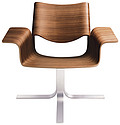Functional Sculpture, the Art Gallery’s current exhibit, was quite the Saturday night hit (drawing one of the biggest opening night crowds the gallery has seen).
Co-curator Glenn Gordon led the event with a talk about the distinction in the art world between the crafts and the fine arts. Crafts are practical, but not works of art, and art is… pretty unpractical, right? Think again. Gordon stressed that any ordinary object can be made in a way so it is “sculpturally compelling.” He passed around a 99¢ bamboo scoop as an example of this. The scoop “succeeds in being what it appears to want to be.” Such a Zen statement, no?
All of the artists featured in the exhibition used furniture to make the crossover from craftiness to fine artistry. Each piece is highly functional (you can stand, sit, or lean on them as you please), but at the same time, the pieces can stand as sculptures whether bright and wacky to quietly sublime. For example, Dean Wilson’s “Cocktail Cart” looks like it has had one too many itself, while Richard Helgeson’s series of tables are symmetrically perfect and self-contained.
After the talk, the Art Gallery remained crowded with students, artists, and interested locals. “This is the most people we’ve ever had,” said Peter Olds ‘08, the gallery’s guard. Several of the artists featured in the exhibit were in attendance to explain their work.
Artist Tim Gorman had an impossible inlaid table called “Ellipsoid Table” on display. Every surface on the table is curved (something akin to a space-time anomaly) and the inlay on the surface is tiny. Plus, on each corner Gorman added a little flare: nine-square checkerboards, each smaller than a dime.
Surely Gorman must have used lasers to make cuts that accurate! “I use all conventional tools,” he said. Gorman admitted to using a computer as part of the building process, but the plurality of his design work is completed on old-fashioned orthographic paper.
In his talk, Gordon showed slides of functional sculpture pieces beyond those included in the exhibit. These ranged from ordinary, mass-produced school chairs to physics-defying works by the famous Japanese designer, Isamu Noguchi. This broad range of style and functionality pushed Gordon to pose a final question: If not all pieces are meant to be utilized, is it fair to label them “functional sculpture”?





